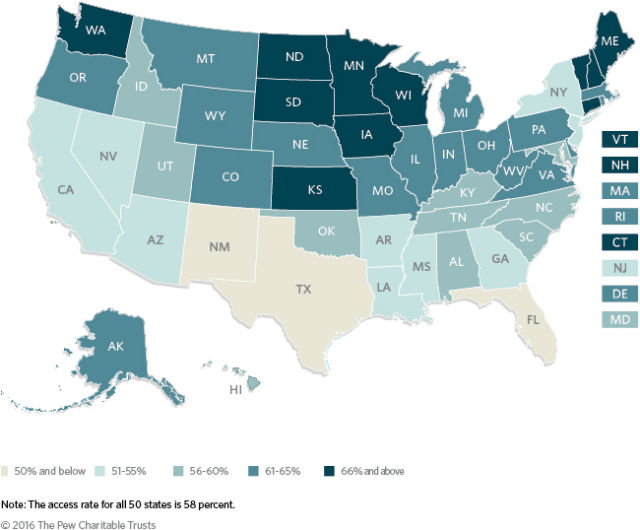Is your state facing a retirement crisis?
It's well known that America is facing a retirement crisis, with only half of U.S. workers participating in a workplace savings plan.
But a new report from The Pew Charitable Trusts highlights how that deficit may impact different states, with the ability to join a retirement plan varying widely across the country. Workers who live in the Southeast and the West are far less likely to both have access to employer-sponsored retirement plans and to participate in them. That could raise the financial burden on states in these regions, particularly those with large numbers of retirees, in the decades to come.
"As elderly people are entering old age and poverty, the state may have additional outlays in terms of assistance," said John Scott, director of Pew's retirement savings project. "It might affect state budgets."
In Florida, for example, that could greatly boost costs given that it has both the lowest rate access to retirement plans and the lowest participation rate in workplace retirement plans. Since the study looked at full-time workers between 18 to 64 years old, the data excludes Florida's sizable numbers of already retired residents.
Only 38 percent of workers in Florida participate in a workplace retirement plan, such as a 401(k) or pension plan, Pew found. The Sunshine State also has the country's lowest rate of access to retirement plans, with only 46 percent of workers offered retirement plans at work. By comparison, 70 percent of workers in Wisconsin have access to retirement plans through their employers.
States in the Southeast, such as Florida, South and North Carolina, and Mississippi, tended to have the lowest rate of retirement plan access in the country, the study found, with only 46 percent of the region's workers participating in a retirement plan.
By comparison, the highest rate of participation is in the Midwest, where 56 percent of workers are saving money for retirement through employer-sponsored plans.
So why don't workers across the U.S. have more equal opportunities to save for retirement? It comes down to several issues, including worker income, which industries dominate within states and employer size.
The industry with the lowest rate of access to retirement plans is the leisure and hospitality sector, with only one-third of employers providing the benefit to their workers, Pew found. And only 23 percent of workers in those industries end up using the retirement plans, which may be due to the lower salaries for workers in those industries. Florida has the third-highest share of workers in the leisure and hospitality workers, after Nevada and Hawaii.
Employer size also makes a difference, given that bigger companies are more likely to offer retirement plans. Workers in Western states such as New Mexico and California were more likely to work at firms with fewer than 50 workers, which is also tied to lower retirement plan access, Pew found.
Lower income is also tied to lower participation and access to retirement plans, with Pew noting that wages and salaries are good indications of job quality. Lower-paid jobs tend to offer fewer benefits, for example.
That also differs by region, with workers in the South more likely to earn less than $25,000 per year. At that income level, employees may not be able to participate in workplace retirement plans even if they have access to them, since all of their income may be needed to cover their daily living expenses.
Some states are taking steps to help workers set aside money for their golden years. California, Illinois and Oregon have adopted legislation that will allow them to offer simple savings plans for employers. Other states are working on similar plans.
And the federal government is hoping to help workers without employer-sponsored plans through its new myRA plan, which debuted late last year. While there's no data yet available on the plan, Pew researchers said they plan on tracking it.
The biggest surprise in the research, Scott noted, was the discrepancy in participation rates and access between states. "We see such a wide variance," he said. "It stresses the need to understand what's going on at the state level."
